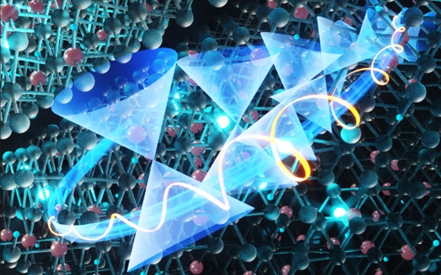
Rendering of the tilting of relativistic Dirac cones in the bulk electronic bands of a quasi-two-dimensional (2D) magnetic topological semimetal achieved with insertion of hydrogen that generates tunable low-dissipation chiral charge currents.
A team of physicists led by The City College of New York’s Lia Krusin-Elbaum has developed a novel technique that uses hydrogen cations (H+) to manipulate relativistic electronic bandstructures in a magnetic Weyl semimetal -- a topological material where electrons mimic massless particles called Weyl fermions. These particles are distinguished by their chirality or “handedness” linked to their spin and momentum.
In the magnetic material MnSb₂Te₄, researchers unveiled a fascinating ability to “tune” and enhance the chirality of electronic transport by introducing hydrogen ions, reshaping on-demand the energy landscapes -- called Weyl nodes -- within the material. This finding could open a breadth of new quantum device platforms for harnessing emergent topological states for novel chiral nano-spintronics and fault-tolerant quantum computing. Entitled “Transport chirality generated by a tunable tilt of Weyl nodes in a van der Waals topological magnet,” the study appears in the journal Nature Communications.
The tuning of Weyl nodes with H+ heals the system’s (Mn-Te) bond disorder and lowers the internode scattering. In this process -- which The City College team tests in the Krusin Lab using angularly-resolved electrical transport -- electrical charges move differently when the in-plane magnetic field is rotated clockwise or counterclockwise, generating desirable low-dissipation currents. The reshaped Weyl states feature a doubled Curie temperature and a strong angular transport chirality synchronous with a rare field-antisymmetric longitudinal resistance -- a low-field tunable ‘chiral switch’ that is rooted in the interplay of topological Berry curvature, chiral anomaly and a hydrogen-mediated form of Weyl nodes.
“The major advance of this work is enlarging the breadth of designer topological quantum materials beyond nature’s blueprint. Tunable topological bandstructures facilitated by hydrogen or other light elements through defect-related pathways expand the availability of accessible platforms for exploring and harnessing topological phases with stunning macroscopic behaviors, opening a path to a potentially disruptive chirality-based implementations in future quantum devices,” said Krusin-Elbaum, professor in CCNY’s Division of Science.
The research in the Krusin Lab centers on exploring novel quantum phenomena such as Quantum Anomalous Hall (QAH) effect, which describes an insulator that conducts dissipationless current in discrete channels on its surfaces, 2D superconductivity, and axion state phenomena featuring a quantized thermal transport, all with the potential if industrialized to advance energy-efficient technologies. Krusin-Elbaum and her team said that the technique they have demonstrated is very general and ultimately may advance the potential of intrinsic topological magnets to transform future quantum electronics.
The CCNY-based Harlem Center for Quantum Materials is a partner in the research. It strives to solve fundamental problems in novel functional materials systems that have vital scientific and technological importance. The research is supported in part by the National Science Foundation.
About The City College of New York
Since 1847, The City College of New York has provided a high-quality and affordable education to generations of New Yorkers in a wide variety of disciplines. CCNY embraces its position at the forefront of social change. It is ranked #1 by the Harvard-based Opportunity Insights out of 369 selective public colleges in the United States on the overall mobility index. This measure reflects both access and outcomes, representing the likelihood that a student at CCNY can move up two or more income quintiles. Education research organization Degree Choices ranks CCNY #1 nationally among universities for economic return on investment. In addition, the Center for World University Rankings places CCNY in the top 1.8% of universities worldwide in terms of academic excellence. Labor analytics firm Lightcast puts at $3.2 billion CCNY’s annual economic impact on the regional economy (5 boroughs and 5 adjacent counties) and quantifies the “for dollar” return on investment to students, taxpayers, and society. At City College, more than 16,500 students pursue undergraduate and graduate degrees in eight schools and divisions, driven by significant funded research, creativity, and scholarship. In 2023, CCNY launched its most expansive fundraising campaign ever. The campaign, titled “Doing Remarkable Things Together,” seeks to bring the College’s Foundation to more than $1 billion in total assets in support of the College's mission. CCNY is as diverse, dynamic, and visionary as New York City itself. View CCNY Media Kit.
Jay Mwamba
p: 917.892.0374
e:
jmwamba@ccny.cuny.edu